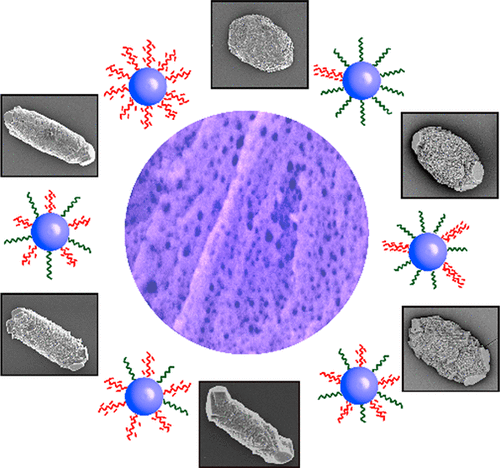当前位置:
X-MOL 学术
›
Chem. Mater.
›
论文详情
Our official English website, www.x-mol.net, welcomes your feedback! (Note: you will need to create a separate account there.)
Influence of the Structure of Block Copolymer Nanoparticles on the Growth of Calcium Carbonate
Chemistry of Materials ( IF 8.6 ) Pub Date : 2018-09-17 00:00:00 , DOI: 10.1021/acs.chemmater.8b02912 Yi-Yeoun Kim 1 , Lee A. Fielding 2, 3 , Alexander N. Kulak 1 , Ouassef Nahi 4 , William Mercer 1 , Elizabeth R. Jones 3 , Steven P. Armes 3 , Fiona C. Meldrum 1
Chemistry of Materials ( IF 8.6 ) Pub Date : 2018-09-17 00:00:00 , DOI: 10.1021/acs.chemmater.8b02912 Yi-Yeoun Kim 1 , Lee A. Fielding 2, 3 , Alexander N. Kulak 1 , Ouassef Nahi 4 , William Mercer 1 , Elizabeth R. Jones 3 , Steven P. Armes 3 , Fiona C. Meldrum 1
Affiliation

|
Block copolymer nanoparticles are versatile crystal growth additives that can be used to both modify crystal morphologies and introduce new properties through their occlusion within the crystal lattice. However, the structural features that make these nanoparticles such effective additives are as yet unclear. This study employs a series of copolymer nanoparticles comprising hydrophobic cores and coronas of carboxylate and hydroxyl polymer chains to establish the design rules that govern the activity of the nanoparticles. Systematic variation of the chemical composition of the nanoparticle coronas and the length of the chains enabled us to explore two closely linked phenomena: crystal habit modification and nanoparticle occlusion within the crystal lattice. We show that nanoparticle activity does not scale directly with carboxylate content and that nanoparticles comprising 50% carboxylate/50% hydroxyl groups were incorporated more effectively than those comprising 100% carboxylate chains. The accessibility of the carboxyl groups is also important, and activity is reduced when the carboxylate groups are embedded within the corona rather than being located on the particle surface. Finally, we demonstrate that occlusion and changes in crystal habit/morphology can occur independently. These results offer a new framework for designing nanoparticles as crystal growth additives, where this provides a novel strategy for preparing inorganic nanocomposites.
中文翻译:

嵌段共聚物纳米颗粒的结构对碳酸钙生长的影响
嵌段共聚物纳米粒子是多用途的晶体生长添加剂,可用于修饰晶体形态并通过其在晶格中的吸收引入新的特性。然而,使这些纳米颗粒成为有效添加剂的结构特征尚不清楚。这项研究采用了一系列包含疏水性核,羧酸盐和羟基聚合物链的电晕和晕圈的共聚物纳米颗粒,以建立控制纳米颗粒活性的设计规则。纳米粒子电晕的化学组成和链长的系统变化使我们能够探索两个紧密联系的现象:晶体习性改变和纳米粒子在晶格内的吸留。我们表明,纳米颗粒的活性并不随羧酸盐的含量直接成比例,并且包含50%羧酸盐/ 50%羟基的纳米颗粒比包含100%羧酸盐链的纳米颗粒更有效地被并入。羧基的可及性也很重要,当羧酸根嵌入电晕而不是位于颗粒表面时,活性会降低。最后,我们证明了闭塞和晶体习性/形态的改变可以独立发生。这些结果为设计纳米颗粒作为晶体生长添加剂提供了新的框架,这为制备无机纳米复合材料提供了新的策略。羧基的可及性也很重要,当羧酸根嵌入电晕而不是位于颗粒表面时,活性会降低。最后,我们证明了闭塞和晶体习性/形态的改变可以独立发生。这些结果为设计纳米颗粒作为晶体生长添加剂提供了新的框架,这为制备无机纳米复合材料提供了新的策略。羧基的可及性也很重要,当羧酸根嵌入电晕而不是位于颗粒表面时,活性会降低。最后,我们证明了闭塞和晶体习性/形态的改变可以独立发生。这些结果为设计纳米颗粒作为晶体生长添加剂提供了新的框架,这为制备无机纳米复合材料提供了新的策略。
更新日期:2018-09-17
中文翻译:

嵌段共聚物纳米颗粒的结构对碳酸钙生长的影响
嵌段共聚物纳米粒子是多用途的晶体生长添加剂,可用于修饰晶体形态并通过其在晶格中的吸收引入新的特性。然而,使这些纳米颗粒成为有效添加剂的结构特征尚不清楚。这项研究采用了一系列包含疏水性核,羧酸盐和羟基聚合物链的电晕和晕圈的共聚物纳米颗粒,以建立控制纳米颗粒活性的设计规则。纳米粒子电晕的化学组成和链长的系统变化使我们能够探索两个紧密联系的现象:晶体习性改变和纳米粒子在晶格内的吸留。我们表明,纳米颗粒的活性并不随羧酸盐的含量直接成比例,并且包含50%羧酸盐/ 50%羟基的纳米颗粒比包含100%羧酸盐链的纳米颗粒更有效地被并入。羧基的可及性也很重要,当羧酸根嵌入电晕而不是位于颗粒表面时,活性会降低。最后,我们证明了闭塞和晶体习性/形态的改变可以独立发生。这些结果为设计纳米颗粒作为晶体生长添加剂提供了新的框架,这为制备无机纳米复合材料提供了新的策略。羧基的可及性也很重要,当羧酸根嵌入电晕而不是位于颗粒表面时,活性会降低。最后,我们证明了闭塞和晶体习性/形态的改变可以独立发生。这些结果为设计纳米颗粒作为晶体生长添加剂提供了新的框架,这为制备无机纳米复合材料提供了新的策略。羧基的可及性也很重要,当羧酸根嵌入电晕而不是位于颗粒表面时,活性会降低。最后,我们证明了闭塞和晶体习性/形态的改变可以独立发生。这些结果为设计纳米颗粒作为晶体生长添加剂提供了新的框架,这为制备无机纳米复合材料提供了新的策略。



























 京公网安备 11010802027423号
京公网安备 11010802027423号